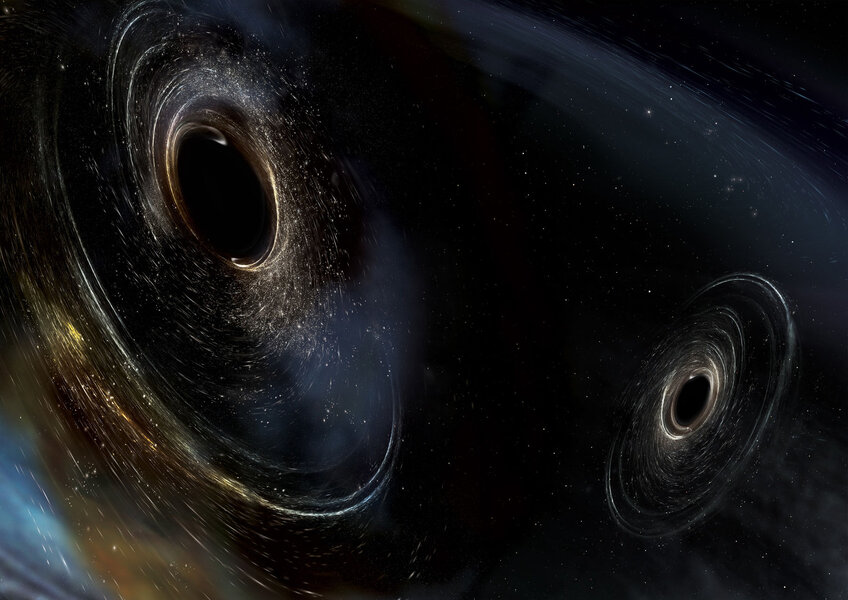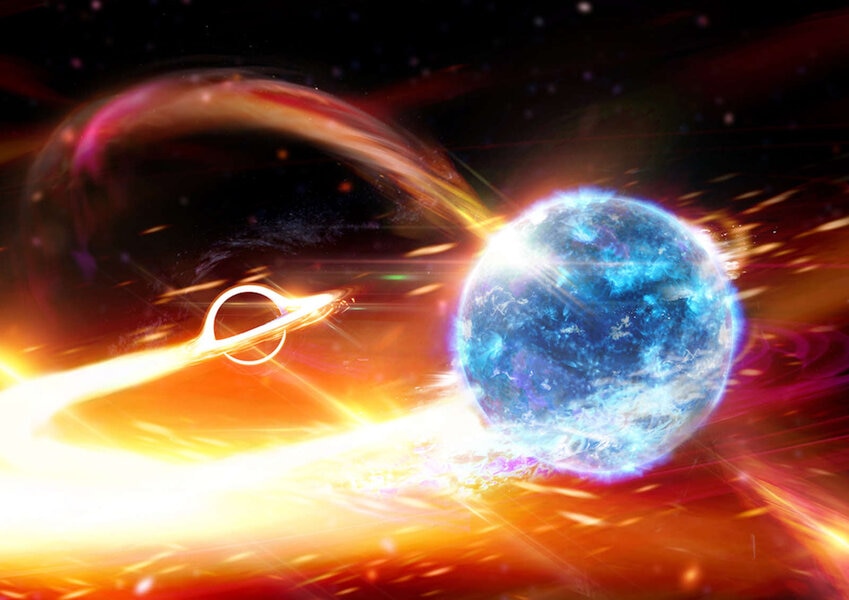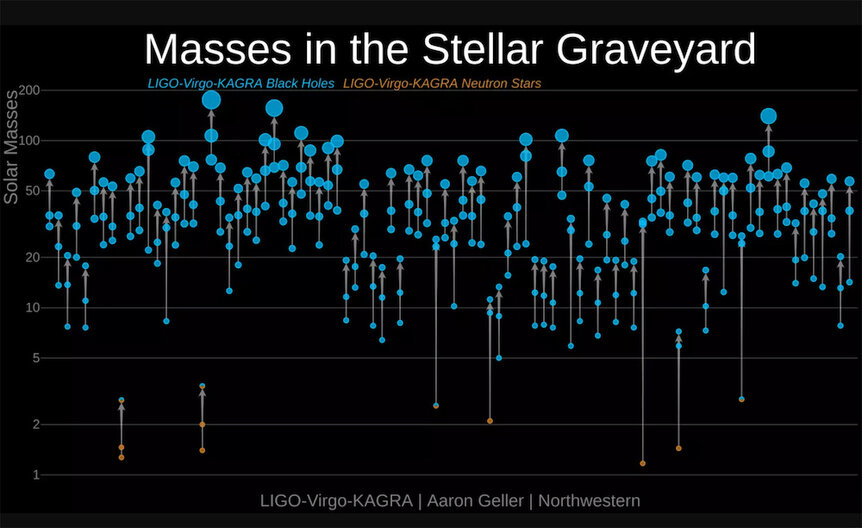Create a free profile to get unlimited access to exclusive videos, sweepstakes, and more!
*Thirty-five* new black hole and neutron star mergers found, bringing total known to 90
Gravitational wave astronomy is coming into its own

A very large team of astronomers has announced they have discovered 35 new compact object mergers — from black holes and/or neutron stars — adding to those previously found in the past few years, which now makes a total of 90 such events seen. These are among the most colossally energetic explosions the Universe is capable of, but, bizarrely, emit literally zero light that has been seen.
The mergers were detected by the LIGO, Virgo, and KAGRA Collaborations, three observatories around the world designed, built, and dedicated to find and analyze these events.
This new passel of mergers had some fun ones, too. One was a black hole that ate a neutron star, and not just any neutron star but one with the lowest mass ever seen. Another created what may be an elusive intermediate mass black hole with more than 100 times the Sun's mass. Another one may be from either the lowest mass black hole ever seen or the highest mass neutron star, too.
These observatories don't look for light. Instead, they look for gravitational waves: The very literal shaking of the fabric of spacetime as two extremely massive but extremely small objects spiral in toward each other and then merge. Einstein's General Relativity predicts that when any object is accelerated in spacetime it creates these waves, a bit like ripples in a bedsheet if you shake it. The strength of these waves depends on how massive the object is, and how hard it's accelerated.
That's where black holes come in. If two orbit each other, the waves they create at first are small, but it takes energy to make them. This steals energy from their obit, so they move closer together. But if they're closer they orbit faster, so they generate more gravitational waves, which steal more energy… it's a runaway effect. It's excruciatingly slow at first, but when the black holes get close enough they're whirling around each other at very near the speed of light — two massive objects being accelerated hard. The waves emitted are sharp and strong, and in the final few seconds — after perhaps billions of years of this dance — the black holes finally approach and coalesce, releasing an immense amount of gravitational wave energy.
These waves then move away at the speed of light, crossing the Universe. As they pass through the Earth they cause spacetime to expand and contract on a very teeny scale, but enough to measure if your instruments are sensitive enough.
And that's where the US LIGO (Laser Interferometry Gravitational wave Observatory), European Virgo, and Japanese KAGRA (KAmioka GRAvitational wave detector) collaborations come in. They use an array of lasers and mirrors separated by several kilometers. When a gravitational wave passes through, it changes the distance between the mirrors — typically by about a thousandth the diameter of a single proton — that can be detected by minute changes in the way the laser photons interact with each other.
The pattern of the waves tell us what the two merging objects were like: Their masses, something about their orbit, the total mass of the final object left behind (usually a bigger black hole), and the energy that went into the event.
The energy is staggering. For example, in this new run they saw an event called GW191109 (a gravitational wave detection on November 9, 2019) where two big black holes with 65 and 47 times the Sun's mass merged, creating a single bigger black hole with 107 solar masses, making it on the low end of what we call intermediate mass black holes, which have proven difficult to detect. The extra 5 times the Sun's mass was converted completely into gravitational waves. This amount of energy will melt your brain: It's roughly about the same amount of energy emitted by all the stars in the entire Universe for that duration of time.
This black hole merger was literally the most energetic event in the Universe but completely invisible. These mergers don't emit any light at all. It all goes into shaking spacetime. Incredible.
Another interesting one they saw was GW191219, where a 31 solar-mass black hole merged with an object with only 1.17 times the Sun's mass. The waves detected are consistent with second one being a neutron star, which would be the lowest mass one ever seen! Normally they form when a massive star explodes, creating a supernova, and the core of the star collapses (or two lower mass white dwarf collide, but they rarely leaves anything behind but a huge explosion), and the neutron star has at least 1.4 times the mass of the Sun. Lower mass ones are possible but very difficult to produce.
Two other black hole/neutron star mergers were seen (which I wrote about at the time) but re-analysis shows that one of them (GW200105) may be a false alarm, though it's not clear.
A third very interesting one is GW200210, where a 24 solar-mass merged with an object that's only 2.83 times the Sun's mass. That it at the very tippy top limit to the mass of a neutron star, but is very low for a black hole as well. It could be either, and I'm not sure which way I would bet. The uncertainty in the mass of the second object is about half the Sun's mass, so if it's heavier than thought it's certainly a black hole, and if it's lighter it's a neutron star. Unfortunately, that's the best that can be said for now.
These observatories go through "observing runs," where they are activated and listening for signals for a few months at a time. They're then turned off for a short time for upkeep, upgrades, mirror cleaning, and so on. This is the third run (called O3) and had a dramatic increase in detection over the first two due to all these upgrades. They're in upkeep mode now, and the fourth run, O4, should start in late 2022. Given the advances made since the beginning — the first gravitational wave event was seen on September 15, 2015 — O4 is likely to see a whole lot more.
This type of astronomy is extremely important. We know a lot about how stars die and form neutron stars and black holes, but detecting them in this way tells us even more, including what happens after. Black holes grow in size this way, which is something we know very little about. We see supermassive black holes a billion times the mass of the Sun in galaxies that are only a billion years old. How did that black hole grow so rapidly? Were mergers involved? Why are some like that one so huge, while others like our Milky Way's central black hole — which is only 4 million solar masses — so small?
Gravitational wave astronomy introduced us to a whole new way to observe the Universe, and a lot of answers to very big questions indeed are possible to find now. We're just getting started.





























